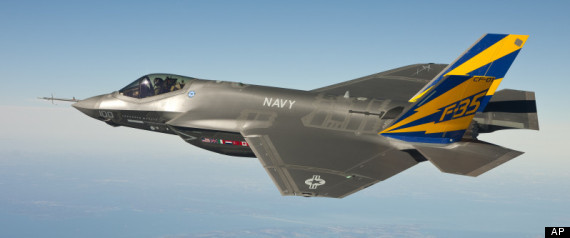F-35: Canadian Jets Will Initially Be Unable To Track Troops, Talk To Older Planes

OTTAWA - The first dozen or so F-35s slated to arrive in Canada won't be equipped with software that allows the stealth fighters to communicate with ground forces, a feature designed to prevent incidents of friendly fire.
The initial operating system also won't be equipped with a program that helps the fighters communicate with older aircraft, such as the Air Force's Aurora surveillance planes.
The software isn't expected to be added until an upgrade program is introduced in 2019 — three years after the Royal Canadian Air Force begins taking delivery the advanced multi-role fighter.
The absence of both items in the initial operating system is alluded to in heavily-censored access-to-information documents, obtained by The Canadian Press and referenced in military publications in the United States.
The system that helps distinguish between friend and foe is known as a Blue Force Tracker, a GPS-enabled device, and its absence means the computers of the first F-35s will not be able to link with ground troops until software is updated.
Aside from being a communications tool, the tracker acts as a check against friendly fire.
Also missing is a feature known as a Link 16, which allows highly advanced aircraft to exchange data, such as text messages, with ships and other, older aircraft in real-time.
Not having either of them could mean that the country's first F-35s would have to stick close to home until the systems are installed and crews are trained in their use.
Officials with the manufacturer, Lockheed Martin, declined to answer questions about the software upgrades, which are divided into a series of blocks.
"Lockheed Martin isn't discussing Block 4 content at this time," said Keelan Green of Thornley-Fallis, an Ottawa company that handles media queries for the U.S. defence giant.
National Defence headquarters in Ottawa also declined comment and referred questions to the Pentagon's joint strike fighter office, which did not respond.
According to the Harper government, being able to operate with allies in complex air-to-ground missions, such as the recently concluded campaign over Libya, is one of the major selling points of the F-35.
It was revealed a few weeks ago that the initial batch of Canadian stealth fighters would not be able communicate in the Arctic without modification — or until the 2019 software update.
Winslow Wheeler, an expert on the American F-35 program who used to work with the U.S. General Accounting Office, said even after the updates are installed, there's still a learning curve.
"Like any new piece of hardware, it'll take years to work them into your force and years to figure out what the limitations are with the system and how to work around it and it'll take money to fill the holes," he said.
Lockheed Martin has long said that the first aircraft would only have basic software. The absence of such key capabilities goes a long way perhaps to explaining why the Canadian government has decided to stagger its purchase of 65 jets out over seven years, with the bulk of them arriving after 2020.
Canada's current fleet of CF-18s reach the end of their service life that year. Opposition parties hammered the Conservative government last week, demanding to know what the back-up plan might be if the F-35 program is cancelled in the U.S. — or delayed any further.
The program is already up to seven years behind schedule.
Wheeler warned politicians that they should be paying attention to those kinds of details and nailing down how much of the software upgrades are covered by the initial purchase — or if they are regarded as sustainment costs.
"This is the kind of game our defence departments play when they want to squeeze the price a little bit," said Wheeler. "It's the continuing story of these kind of problematic systems. The more you scratch the surface, the more you find things missing — or delayed."
Associate Defence Minister Julian Fantino has said there is a Plan B in the case of more F-35 hang ups, but he refused to discuss it and would only focus on the impending purchase, which could cost taxpayers between $16 billion and $30 billion, depending upon the estimate.
The Australians, concerned about delays, have opted to purchase a handful of the Boeing Super Hornets, the upgraded version of the F-18. At the same time, the U.S. Air Force has delayed retiring 350 of its F-16 Tomcats in favour of upgrading them until the F-35 arrives.
The U.S. marines inked a deal this week with Britain to buy their entire mothballed Harrier jump jet fleet. The idea would be to cannibalize the British planes for parts in order to keep their vertical take-off jets functioning until 2025.
There has been no similar discussion in Canada.
"You'd think they'd be asking Boeing for some figures on service life extension plans," said Wheeler.


First Posted: 11/22/11 03:50 PM ET Updated: 11/22/11 05:34 PM ET